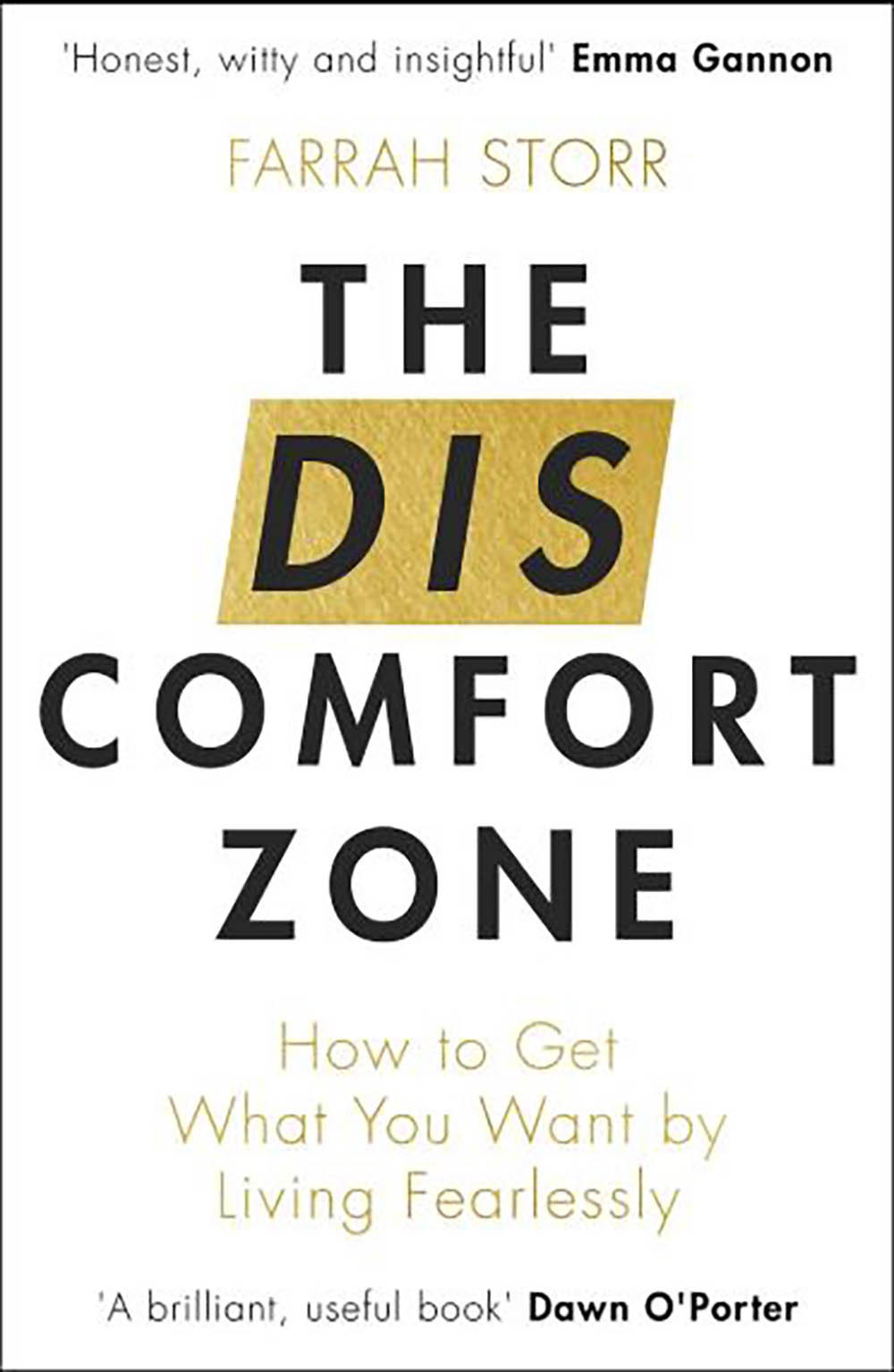Editor-in-chief of Cosmopolitan Farrah Storr, reveals how stepping into her ‘discomfort zone’ and using her BMD Method aka the ‘HIIT training for your life’ has allowed her to face the things that scare her most with confidence
Exams – one thing we’ve all had the pleasure or displeasure of experiencing. Outside an exam room there are those who are freaking out, the ‘I can’t do this’ types, there are also those who are sat in excited anticipation with a coffee in one hand, some cue cards in the other saying, ‘I wonder if this question will come up’.
The people who look like they’re on the verge of breakdown are those that see an exam as a ‘threat’, whereas the excitable person sees an exam as a ‘challenge’.
‘It’s a funny thing, the human brain. It looks for easy absolutes to create a scary narrative’ says Farrah Storr, award-winning editor-in-chief of Cosmopolitan. ‘A narrative that if you’re not careful will paralyse you’.
An exam for most people will be slightly nerve-racking of course but sometimes you feel like you just can’t do it, that you’d give anything to run in the opposite direction and never look back, that feeling is when you have entered your ‘discomfort zone’.

Realistically, the discomfort of taking that exam is rarely as bad as we think it will be, it’s over before we know it, we haven’t died from the terror of it all and well if it isn’t your finest hour then you’ll figure something out in the end.
‘Discomfort is not constant, but fleeting, says Storr. ‘Neither is discomfort debilitating, it is empowering’.
In fact taking an exam aka being thrown into an uncomfortable situation, can even result in your best work – think of that essay that you did in just one night when you ended up getting top marks.
When the added pressure builds, you are challenged and pushed into what Storr calls your ‘discomfort zone’.
Although most people are pushed into their discomfort zone by forces outside of their control, pushing yourself into this zone will help you reach your full potential. ‘Stepping into your discomfort zone is the quickest way to find your potential,’ says Storr.
But how do we push ourselves into this ‘discomfort zone’? Enter Farrah Storrs ‘BMD Method’.
The BMD Method
BMD stands for ‘Brief Moments of Discomfort’ because that’s what discomfort is says Storr, teeny, tiny little frissons of pain that pass almost instantaneously.
Storr reveals that she has been using the BMD method over the past five years and it has not only transformed the way she lives her life, but also the quality of the life she lives.
Step #1: Find your fear
Storr explains that to find your fear you must identify where your comfort zone ends and your discomfort zone begins.
In identifying our fear we can then identify the exact moment in which we step into our discomfort zone, and all the associated feelings that come with that – the racing heart, sweaty hands and general sense of dread.
It’s important to acknowledge and understand these reactions, as only then are we able to control them. Once you understand the bite-sized nature of your fear you’ll be able to take on anything – maybe not the world but you get the point.
Step #2: Feeling comfortable with discomfort
Storr explains that there are two types of comfort, ‘deadly comfort’ and ‘active comfort’.
‘Deadly comfort is the sort that has people rotting in dead-end jobs and comatose relationships,’ says Storr. Deadly comfort according to Storr requires zero thought, zero discipline and therefore zero gains. Ultimately you’re going nowhere.
Active comfort however, means you are able to feel comfortable in an uncomfortable situation, for example having a line prepared should you be asked a tricky question at a job interview. This creates a positive state of being, rather than a lazy state of mind.
Step #3: Re-imagining discomfort
Storr explains that this is the fun part. This is where you start imagining all the things you could and can do with your life because you have sussed out what discomfort really is.
After recognising that discomfort is no more than a few seconds of feeling uncomfortable you’ll come to realise that discomfort is not disruptive but constructive. Storr says that once you can see through the clearing mist you’ll see discomfort as an invigorating challenge to overcome rather than a struggle.
‘Those very situations where we feel alarmingly out of our depth are crucial for progression and success,’ says Storr.
5 steps to finding YOUR discomfort zone
Learning to like adrenaline
Nerves – as horrid as they seem they are almost always a good thing. ‘Adrenaline isn’t a sign to stop but a sign to go on,’ says Storr. Adrenaline is your body’s way of getting ready for action or a challenge.
We all know the feeling of when adrenaline strikes right? It’s a natural feeling that comes to us multiple times a week, month or year. It’s human nature’s way of helping us thrive in difficult situations.
For example, walking home late at night, you probably walk a bit faster and cross the road if you see someone suspicious ahead of you. Adrenaline isn’t the best feeling in the world but in most instances, we need this flight or fight mode to get through even the smallest challenge.
So how do we learn to ‘like’ adrenaline? It’s simple, accept that you’ll need it in order to succeed. By retuning the way we see an uncomfortable situation, thinking positive thoughts such as, ‘I will perform better thanks to these nerves,’ chances are you probably will.
Recognise those nerves, accept them and realise that you need them. Having control, self-belief and focus will guarantee you success.
Montaging
When faced with an upcoming uncomfortable situation, Storr likes to imagine the who, what, where and why before she even gets there, this she calls ‘montaging’.
When thinking about a job interview, chances are you only worry about what could go wrong rather than thinking about what may go right, right? According to Storr, we ‘negativise’ everything, tripping up, spilling the water, getting tongue tied, we always imagine the worse.

How do we do this ‘montaging’ thing I hear you ask? Storr advises that firstly you set the scene. Taking the job interview example again, Google map where it’s going to be. What area is it in and what street is it on? Is there any traffic, a coffee shop? Keep adding detail as it comes to you says Storr.
Visualise what shoes you will have on, what your hair will look like. Create the sensory experiences too. The smell of a coffee machine, the noise of a ringing phone, aim for at least five associated sensory experiences to add to your montage.
Storr advises that as soon as you have an event you are feeling nervous about, start montaging, and do this as many times as you can. Start acting it out too with a script if that helps and slow your breathing while you practice.
Storr says ‘you’ve got to think it to be it, imagining yourself succeeding in a situation can have a significant effect on the outcome’. Although, if you aren’t a naturally in your face, confident person, don’t imagine that you are, keep it realistic to you.
Having a plan that you have rehearsed over and over will help you feel in control of the situation, helping you feel comfortable in an uncomfortable situation.
Journalling
Traumatic things happen, that’s just life. For some the trauma can be major and for others it can be minor, such as being yelled at by your boss in front of all your colleagues.
When these traumatic events happen it’s tempting to throw in the towel and give up. But Storr suggests that we take it on the chin and ‘write’ down our feelings.

‘Journaling is a great way of rinsing a painful experience of it’s discomfort’ this is also known as ‘exposure therapy’, forcing yourself to come face to face with the trauma time and time again. Dissect it, pull it apart like a jigsaw and examine every piece in detail, suggests Storr.
When going for a run do you often find yourself thinking ‘I’ll run to that lamppost and then slow down or I’ll run to the end of this road and then I’m halfway there? Thinking about each small landmark rather than the run as a whole makes it less painful and more enjoyable. You dissect that run into parts because thinking about the whole thing would mean you probably wont even leave the house.
It’s the same with something significant that has upset you. Thinking about the trauma as a whole will upset and overwhelm you, but breaking it apart, bit by bit will help you figure out which part really upset you, the rest you will probably forget about.
Storr says that we should take 15 minutes (set an alarm) with your diary open and your pen poised. Regale as much detail about what upset you as possible. Write down how did this happen? Why did it happen? And what could have caused it. Keep picking at the problem until you get to the core of the discomfort.
Heard of the saying ‘get back on the horse that bucked you’, turn your trauma into triumph by going over what caused you discomfort in the first place.
Letting go of what people think
We care what people think and that’s a fact. We both value and fear the judgement of those around us, we just can’t help it.
But in reality nobody really cares about what you’re doing. In fact they probably didn’t even notice that you fell up that step and if they did they probably thought about it for 0.3 of a second.

‘The truth is, most people are too busy thinking about themselves to think about you,’ says Storr. The discomfort you feel whilst giving a speech or walking out onto stage, truth is the audience probably aren’t thinking about you at all, instead they are listening to your amazing speech or thinking about what to have for dinner later – just joking, maybe.
We will always think that people are noticing more than they actually do. And guess what? Everyone feels the same. Simply knowing this should make you feel a hella lot better. By learning to get over what people think of you, you could probably cut your feelings of discomfort in half.
Ditching ‘the slog’ for ‘the grind’
When you hear the word ‘grind’ do you think of hard work, laborious discomfort, relentless, repetitive or all of the above?
According to Storr the grind is not something to be afraid of as it actually means you’re moving forward. Storr describes the ‘grind’ as a transformative act that is the run-up to your breakthrough leap. The ‘grind’ although it may feel relentless should involve small moments of change, that feel as if things are shifting and moving forward.
The ‘slog’ however is that relentless, unchallenging work that will have you feeling like you’re going nowhere. The ‘comfortable’ slog will just drag you down rather than challenge you.

If your job isn’t motivating you but instead crushing your spirit and making things feel impossible, chances are it is impossible and you’ll end up going nowhere.
The uncomfortable ‘grind’ however, although it may feel like the slog sometimes you should still feel challenged and thrown into discomfort in order to grow and achieve success.
So do you think you can find your discomfort zone?
‘Pushing yourself into your own discomfort zone is not easy. Often we only find ourselves there by chance, circumstance or the force of someone else.
‘Forcing yourself into a zone where things get harder, the pressure gets fiercer and you feel totally out of your depth is something only a few can do,’ says Storr.
From now on, say yes and figure out the solution later. Storr insists that we say yes to something we have always wanted to do. Every. Single. Month. Nod your head, agree and figure the rest out later.
And remember it’s only those BMD’s that are causing all the trouble. Embrace the challenge, charge through life and learn to feel comfortable with uncomfortable.
Here’s a video of Farrah giving a TEDx talk on the matter:

The Discomfort Zone, by Farrah Storr is available to buy now.
Related Healthista Content:
7 ways positive thinking is STOPPING you achieving your goals
7 happiness short cuts this psychologist wants you to do every day
